It is the kind of house that would kindle hot pangs of desire in even the most imperturbable editor at Dwell magazine: Clean, horizontal lines. Walls made of Betón brut concrete. Floors and ceilings from fine-grain hardwood. There is a pristine island kitchen with an induction cooktop and temperature-controlled wine storage. Plus, near the entrance, a graceful internal courtyard harbors a cluster of bamboo trees — illuminated, of course. (Uplighting vegetation is the design tic of the bourgeoisie.)
If the Academy of Motion Picture Arts and Sciences were to grant an Oscar for architecture as a character in a movie, the Minimalist manse inhabited by the well-to-do Park family in Bong Joon Ho’s “Parasite” would certainly be the lead contender. The home, which in the film is designed by a fictional starchitect named Namgoong Hyeonja, hits all the markers for tasteful displays of wealth, from the Minimalist furnishings to the Minimalist soaking tub — a desire for less-is-more that applies to everything except scale.
But as design critic Kyle Chayka writes in “The Longing for Less: Living With Minimalism,” his newly released book about the desire for less, “Just because something looks simple does not mean it is; the aesthetics of simplicity cloak artifice, or even unsustainable excess.”
In the case of the Park home, the simplicity cloaks a disquieting secret in the basement.

A scene from Bong Joon Ho’s “Parasite” showcases the Minimalist home of the well-to-do Park family.
( Neon / CJ Entertainment)
Each of the best-picture nominees for the 92nd Academy Awards employed architecture and urbanism to help tell stories.
Martin Scorsese offered an epic take on a mobster’s regret-filled life in “The Irishman,” a picture redolent of clubby, Old World restaurants. “Ford v Ferrari” and “Once Upon a Time … in Hollywood” traveled to the 1960s, a world of Space Age neon, wood-paneled executive suites and ranch-style houses. Noah Baumbach’s “Marriage Story” remained firmly in the present, offering a realistic view of a crumbling relationship set against blandly tasteful middle-class domestic settings and the barren Los Angeles apartment inhabited, at one point, by Adam Driver’s character, a setting whose principal design feature is beige wall-to-wall carpet.
The two best-picture films that take place in wartime are among the most intriguing for the ways in which they employ architecture — and its absence. So it is little surprise that both also received Oscar nominations for production design.
Taika Waititi’s “Jojo Rabbit,” which takes place during World War II, tells the fantastical tale of a German boy and his imaginary friend — who happens to be Hitler.
The exteriors (shot in the Czech Republic) evoke a Baroque German city. But the interiors of the home, where much of the action takes place, features Modernist, Art Deco design flourishes and boldly colored wallpapers — as if this home were a cocoon against everything happening outside. (A cocoon that happens to be hiding a young Jewish woman.)
Hitler, for the record, hated Modernism.
Quite different in its approach to architecture is Sam Mendes’ riveting “1917,” set on the Western Front during World War I. This war epic shows little in the way of architecture — but when it does, it is the stuff of nightmares.
There is the design of the trench, where so much of the film takes place, and where countless lives come to an end in a soup of mud and waste. But the most memorable scene shows George MacKay as Lance Cpl. Schofield running for his life through the bombed-out French village of Écoust-Saint-Mein at night, flares and bombs illuminating the wreckage of this once picturesque settlement.
It is a hellscape. The end of architecture. Its crumbling ruin seeming to contain only the last vestiges of human life.
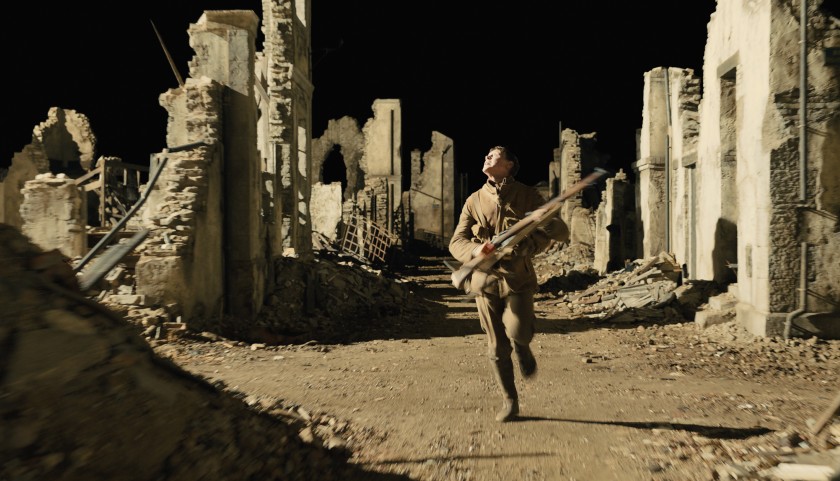
George MacKay as Schofield dashes through a destroyed French village at night in “1917.”
(Universal Pictures)
Taken collectively, however, the best-picture nominees deploy architecture in ways that tell compelling stories about the ways in which the poor and the wealthy divide.
Greta Gerwing’s “Little Women” is about the March sisters wrestling with the life options available to them in Civil War-era Concord, Mass. — options that seem to sit on a continuum between getting married and thwarted attempts at a creative life. But the film also tells a story of class and the ways in which women aspire to it.
The home belonging to the kindly and well-to-do Mr. Laurence, a Georgian Revival mansion played by the Nathaniel Thayer Estate in Lancaster, Mass., sits right within view of the March family’s more humble abode, a 17th century colonial farmhouse painted a dreary shade of brown. The drafty home of the poor Hummel family down the road highlights the social classes even further. In the Laurence home, the wood trim sparkles; in the March house, the surfaces have a genteel worn-out-ness, with flowered wallpaper that has dulled over time. The Hummels can only dream about wallpaper.
Those details are hardly incidental. The March home is based on author Louisa May Alcott’s Massachusetts home, where she wrote the novel upon which the movie is based. “Our version of the March house is a bit broken and run-down on the outside,” production designer Jess Gonchor told The Times last year, “but the interiors have this flow of positive energy and color.”
But they are interiors, as the March sisters are keenly aware, that constantly speak to their status.
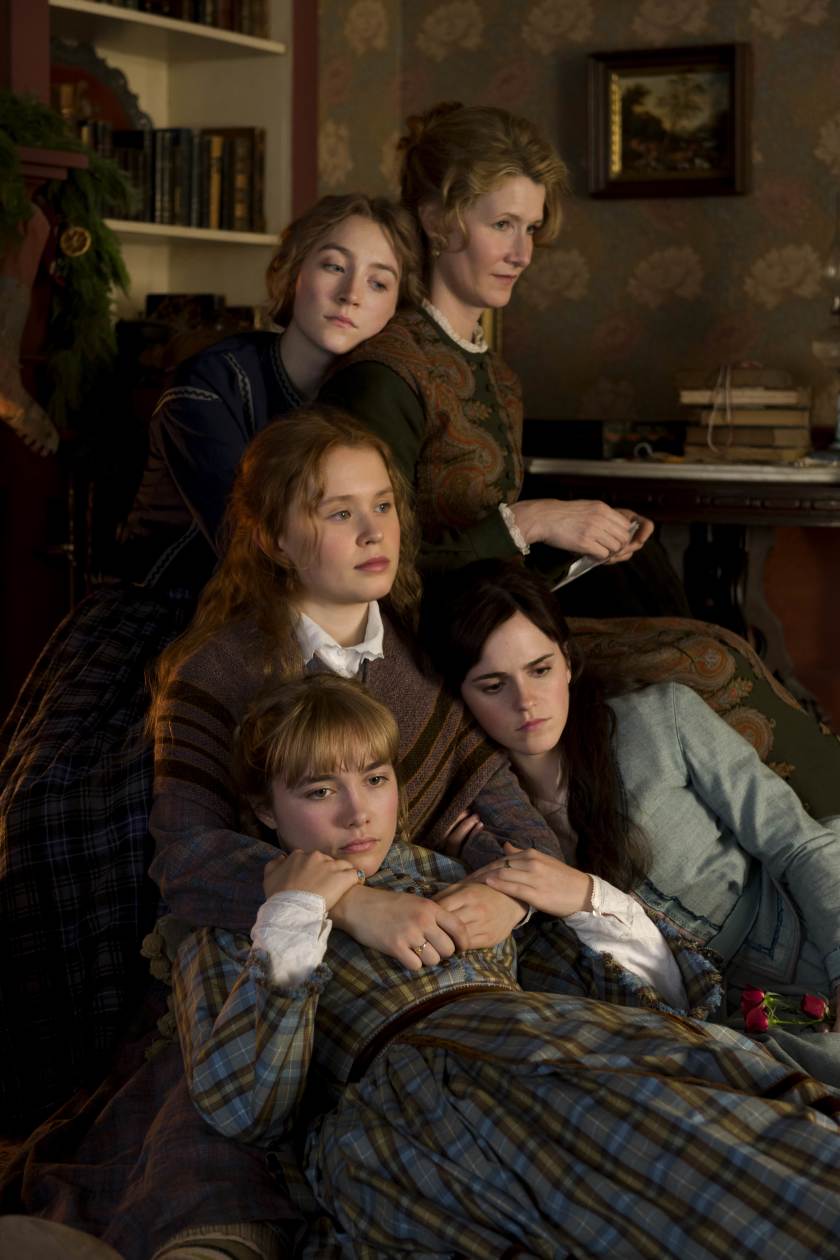
Saoirse Ronan (clockwise from top left), Laura Dern, Emma Watson, Florence Pugh and Eliza Scanlen, at home as the March family in “Little Women”
(Wilson Webb / Columbia Pictures)
Quentin Tarantino’s “Once Upon a Time … in Hollywood,” which is also up for an Oscar for production design, likewise offers some interesting juxtapositions of rich and poor.
The camera lovingly dwells on the creature comforts of the Hollywood Hills home that belongs to actor Rick Dalton, played by Leonardo DiCaprio, including a full bar and a turquoise swimming pool with L.A. views. Cut to the home of Brad Pitt’s barely employed stuntman Cliff Booth, a banged-up trailer behind the Van Nuys Drive-In. It is stuffed with decidedly unfancy clutter: the dishes in the sink, the dirty dog bowl in the corner, the television on a teetering TV tray.
“We wanted to put Cliff in the realm of a drive-in,” production designer Barbara Lin told the Hollywood Reporter of the concept. “I love that whole environment for Cliff, putting him in such a different world from the [glamorous one] in which he serves as stuntman.”
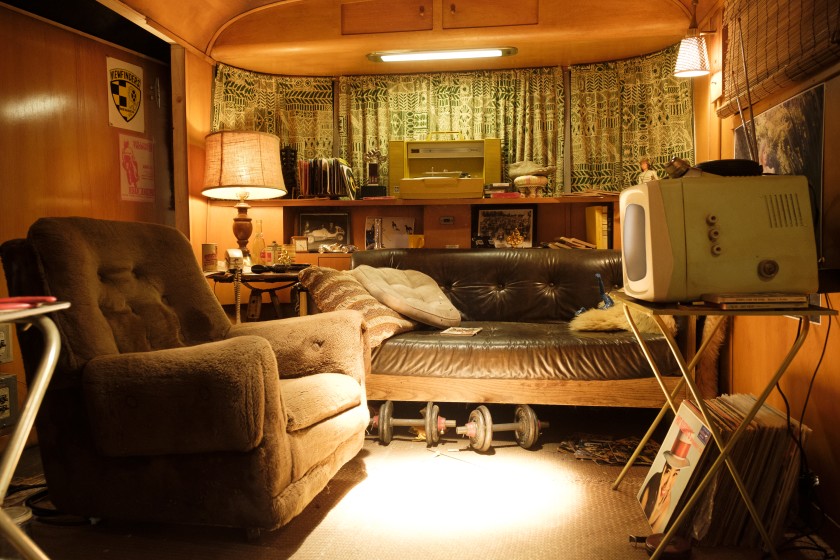
The disheveled trailer belonging to Cliff Booth (played by Brad Pitt) in “Once Upon a Time … in Hollywood.”
(Andrew Cooper / Sony Pictures)
Todd Phillips’ “Joker” goes beyond individual environments.
The film opens with Joaquin Phoenix, as Arthur Fleck, applying clown makeup in a gloomy, industrial room as radio news reports talk about Gotham’s garbage crisis. Shortly thereafter, he is assaulted by a group of teens in an alley. Thus begins a spiral that puts the emotionally unstable Fleck on the path to becoming the Joker. And part of that path is the one of a society afflicted by rampant economic inequity — all conveyed by the crumbling prewar apartment building that Fleck inhabits, with its flaking paint and dire hallways.
It is also conveyed by the city itself, a rat-filled, crime-saturated Gotham that evokes the New York City of Bernhard Goetz, the vigilante who shot four African American teens on the New York City subway in 1984. A similar scene occurs in “Joker,” in which Fleck shoots at a pack of bratty financiers who bully him on the train. (In a case that made national headlines, Goetz was found not guilty on all charges except for carrying an unlicensed weapon.)
The film is every paranoia about the urban rendered on screen: a vision of cities as festering sites of crime and filth, evocative of the “Ford to City: Drop Dead” New York of the 1970s and the ways Donald Trump talks about Chicago today. All of it is paralleled by the wealthy moguls who seem untouched by the decay.
Fleck’s sickly mother is hopeful that one of those moguls, Thomas Wayne, whom she once knew, will rescue her and her son from their grinding poverty.
That, however, is not in the cards. As Fleck’s counselor tells him, after funding is cut for his mental health services, “They don’t give a … about people like you, Arthur. And they really don’t give a … about people like me either.”
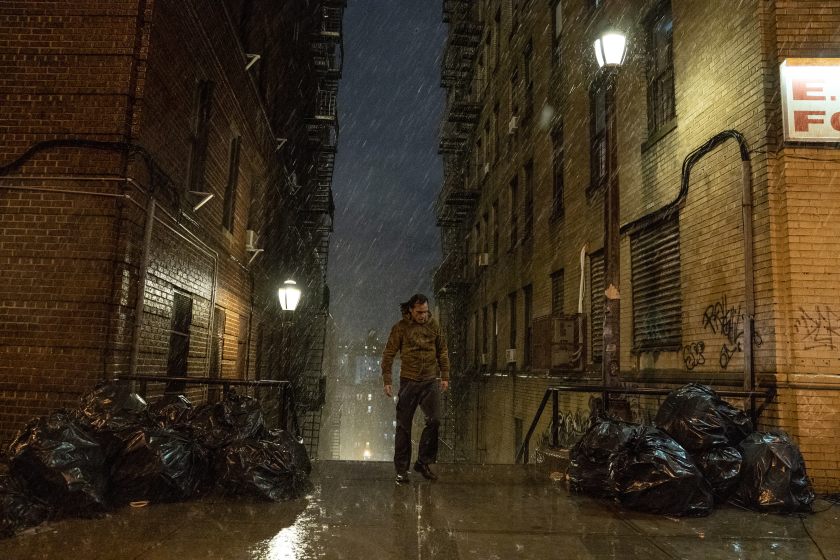
Joaquin Phoenix as Arthur Fleck in “Joker” navigates a trash-covered street evocative of 1970s New York.
(Niko Tavernise / Warner Bros. Pictures)
But it is ultimately “Parasite” that uses architecture to tackle the topic of inequity in the most direct ways: a tragicomic story about the parallel lives of the wealthy Park family and the poor Kim family that work for them in an array of household jobs — jobs acquired through various ingenious scams. But even before the plot has begun to unfurl, the architecture in the film has already articulated the class tension.
The Parks inhabit a state-of-the-art estate. The Kim family lives in a style of semi-basement apartment that is common to Seoul, where the film is set. Known as banjiha in Korean, this style of housing offers little in the way of creature comforts such as daylight. Contrast that to the Parks’ large picture window, which overlooks a vast, manicured garden.
It is the Kims’ banjiha that opens the film: with socks drying before a row of four grimy windows. Milk crates stacked high against walls burst with clutter. The wires that provide electricity are visible as they run along ceilings and walls. A tiny bathroom features not a soaking tub, but a toilet set on an elevated platform (presumably a way to flush waste without having to dig any deeper for plumbing).
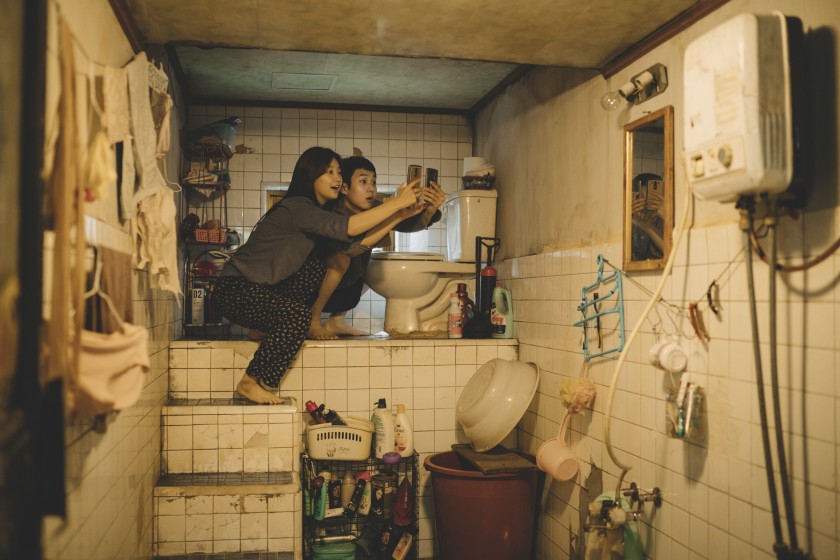
Park So Dam (left) and Choi Woo Shik in their semi-basement bathroom in “Parasite.”
( Neon)
In an interview with Indiewire last fall, Lee Ha Jun, who nabbed an Oscar nomination for his production design on the film, described the toilet as “a temple of excrement.” It is no wonder the Kims will do whatever it takes to worm their way into the Parks’ sumptuous home.
None of it, however, results in what they imagine.
Those pristine magazine homes? It turns out they have plenty of room for skeletons in their capacious, walk-in closets.




